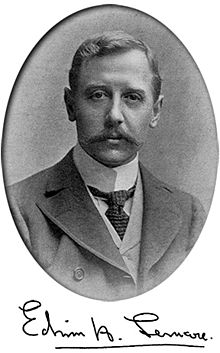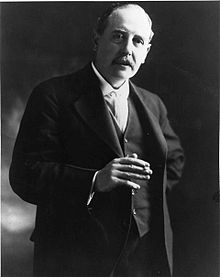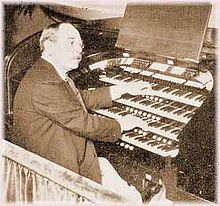Edwin Lemare
Edwin Henry Lemare (born September 9, 1865 in Ventnor , Isle of Wight , England , † September 24, 1934 in Los Angeles , California ) was an English organist and composer . At the turn of the century he was one of the most famous organists in the English-speaking world.
Life
Edwin Henry Lemare received his first musical training as a choirboy and organist at Holy Trinity Church in Ventnor from his father, a music salesman who was also called Edwin. He then studied for three years at the Royal Academy of Music with Sir George Alexander Macfarren , Walter Cecil Macfarren, Dr Charles Steggall and later with Dr. Edmund H. Turpin and received his Fellowship Diploma (FRCO) at the Royal College of Organists in 1886. In 1892 he was appointed professor of organ and examiner on the Associated Board of the Royal Schools of Music .
Lemare first caused a sensation when, in 1884, at an exhibition of inventions, he played over 100 concerts on a single-manual organ made by Brindley & Foster, with two concerts a day. This was followed by a job at Park Hall in Cardiff , where he gave concerts twice a week. From 1886 Lemare went on extensive concert tours throughout England.
Since his studies, Lemare held various positions in parishes in the London area, but also in Sheffield and Cardiff. At St Margaret's Church in London, where he worked from 1897 to 1902, a three-manual organ was even built by the company JW Walker and Son in 1896/97 according to Lemares' ideas.
Due to his increasing popularity, Lemare soon undertook extensive concert tours abroad, including a tour with over 100 concerts through the USA and Canada in 1900 and 1901. After this concert tour he gave up his position at St. Margaret's and settled in the USA, where he also held various positions. Nevertheless, he went on concert tours that took him to New Zealand and Australia in addition to Europe and America . There he was involved in the planning of the organs in the Auckland Town Hall and Melbourne Town Hall.
In 1925, Lemare accepted a position as organist at the Soldiers and Sailors Memorial Auditorium in Chattanooga , Tennessee . There, the Austin Organ Company built a four-manual organ the year he took up his duties, the disposition of which also goes back to Lemare. However, Lemare gave up his last job in 1929. He died in Hollywood in 1934 .
Employment as organist
- St Mary's, Brookfield, Highgate
- St John's, Finsbury Park , 1882
- Park Hall, Cardiff
- Sheffield Parish Church , 1886
- Albert Hall, Sheffield, 1886
- Holy Trinity, Sloane Street, London, 1892
- St Margaret's Church, Westminster , 1897–1902
- Carnegie Institute , Pittsburgh , 1902-1905
- Panama-Pacific International Exposition , San Francisco, 1915
- Municipal organist in San Francisco , 1917–1920
- Portland , Maine , 1921-1923
- Organist, Soldiers and Sailors Memorial Auditorium, Chattanooga, Tennessee, 1924–1929
Act
Compared to his contemporaries, Lemare had an extremely rich repertoire, which, in addition to pieces originally written for the organ, also included transcriptions of well-known orchestral works, for example by Pyotr Tchaikovsky or Richard Wagner . Recordings for the Aeolian-Skinner Company (24 roles) in Dorchester in Massachusetts and for M. Welte & Sons in Freiburg im Breisgau in Germany bear witness to his playing . As one of the best-paid concert organists of his time, he never kept his positions permanently; instead he spent most of his life on concert tours, some of which he played in front of over 10,000 people. Allegedly, he crossed the Atlantic so often that the ship's personnel addressed him by name.
Moonlight and Roses
The Andantino in Des, known under the name “Moonlight and Roses”, op. 83 No. 2 (1888), is one of the few compositions by Lemare that is still played today. In the meantime this work was so popular that the audience asked for it at least as an encore in every concert. Although several thousand copies of the sheet music sold, Lemare initially made no profit from his work, since he had sold it to the publisher Robert Cocks for a fixed sum of three pounds sterling when it was published in 1892. The name "Moonlight and Roses" does not come from Lemare himself, but from a text that the American songwriters Ben Black and Charles N. Daniels (under the pseudonym Neil Moret) wrote illegally in 1921 for Lemare's work:
Moonlight and roses Bring wonderful mem'ries of you. My heart reposes In beautiful thoughts so true. June light travel Love's olden dreams sparkling anew, Moonlight and roses Bring mem'ries of you.
Finally, in 1925, Lemare took legal action to get the rights to his piece back.
Organ works
Own works
- Allegretto in B minor
- Andante Cantabile in F (Op. 37)
- Andantino in Des (known as “Moonlight & Roses”)
- Arcadian Idyll (Op. 52) (1: Serenade; 2: Musette; 3: Solitude)
- Barcarolle in As
- Bell Scherzo (Op. 89)
- Bénédiction Nuptiale (Op. 85)
- Berceuse in D
- Cantique d'Amour (Op. 47)
- Caprice Orientale (Op. 46)
- Chanson d'Été in B flat
- Chant de Boneur (Op. 62)
- Chant sans paroles in D
- Cloches Sonores (Basso Ostinato) - Symphonic sketch (Op. 63)
- Communion “Peace” (Op. 68)
- Concert Fantasia in F
- Concert piece No 1 - In the form of a Polonaise (Op. 80)
- Concert piece No 2 - In form of a Tarantella (Op. 90)
- Contemplation in D minor (Op. 42)
- Elegy in G
- Evening Pastorale “The Curfew” (Op. 128)
- Fantaisie Fugue in G minor (Op. 48)
- Fantasy Dorienne in the form of variations (Op. 101)
- Gavotte Moderne in As
- Gavotte à la cour (Op. 84)
- Idyll in it
- Impromptu in A
- Intermezzo: Moonlight (Op. 83/2)
- Intermezzo in Bb (Op. 39)
- Irish Air from “County Derry” (arr. By)
- Madrigal in Des
- Marche Heroïque (Op. 74)
- Marche Solennelle in Es
- Meditation in Des (Op. 38)
- Minuet Nuptiale (Op. 103)
- Nocturne in B minor (Op. 41)
- Pastoral No 2 in C
- Pastoral Poem (Op. 54)
- Pastoral in E
- Rêverie in Eb (Op. 20)
- Rhapsody in C minor (Op. 43)
- Romance in Des
- Romance in Des (No 2) (Op. 112)
- Salut d'Amour (Op. 127)
- scherzo
- Second Andantino in Des
- Sonata No 1 in F (Op. 95) (1: Maestoso; 2: Largo; 3: Scherzo; 4: Intermezzo; 5: Finale)
- Spring Song - From the South (Op. 56)
- Summer Sketches (1: Dawn; 2: The Bee; 3: The Cuckoo; 4: Twilight; 5: Evening) (Op. 73) Sunshine (Op. 83/1)
- Symphony No 1 in G minor (1: Allegro Moderato; 2: Adagio Cantabile; 3: Scherzo; 4: Finale) (Op. 35)
- Symphony No 2 in D minor (1: Maestoso con fuoco; 2: Adagio patetico; 3: Scherzo; 4: Allegro giusto) (Op. 50)
- Tears and Smiles (1: Tears; 2: Smiles) (Op. 133)
- Toccata di concerto
- Twilight Sketches (Op. 138) (1: Sundown; 2: The Glow-Worm; 3: The Fire Fly; 4: Dusk)
Transcriptions
Johannes Brahms
- Academic Festival Overture (Op. 80)
- Hungarian dance (No 5)
Edward Elgar
- Gavotte in A
- Idyll (Op. 4/1)
- Pomp & Circumstance March No. 1 (Op. 39)
- Salut d'Amour (Op. 12)
- Sursum Corda (Élévation) (Op. 11)
- Triumphal March from Caractacus (Op. 35)
Richard Wagner
- Overture to The Flying Dutchman
- Overture to The Mastersingers of Nuremberg
- Overture to Rienzi
- Overture to Tannhauser
- The Ride of the Valkyries from Wagner's Valkyrie
literature
- Edwin H. Lemare: Organs I have Met. The Autobiography of Edwin H. Lemare, 1866-1934. Together with Reminiscences by his Wife and Friends. Schoolcraft, Los Angeles CA 1956, (Reprinted by Organ Literature Foundation, Braintree MA 1992, ISBN 0-913746-32-0 ).
- Nelson Barden: Edwin H. Lemare. In: The American Organist. ISSN 0164-3150 :
- Part 1: Becoming the Best. (January 1986, Vol. 20, No. 1, pp. 58-66),
- Part 2: Pittsburgh and Australia. (March 1986, Vol. 20, No. 3, pp. 50-55),
- Part 3: The Midlands, Liverpool, Freiburg. (June 1986, Vol. 20, No. 6, pp. 76-82),
- Part 4: San Francisco, Portland, Chattanooga, Hollywood. (Aug 1986, Vol. 20, No. 8, pp. 44-53).
Web links
- Edwin H. Lemare : His detailed biography. English and French version.
- Recordings : 'In 1913, at the height of his career, Lemare recorded 96 roles for Welte-Mignon in Freiburg. These recordings were performed again in 1973 on the Welte Tripp organ of the Church of the Covenant in Boston. '
- World Restored. Welte Organ at Sir David Salomons house, Royal Academy of Music, 2011
- a letter by Lemares, in which he describes his wife as his 'other eleven sixteenths' (other eleven sixteenths) ( Memento of September 27, 2011 in the Internet Archive )
- The Citizens' Committee To Preserve The San Francisco Municipal Pipe Organ Website and video of the Citizen's Committee to Preserve The San Francisco Exposition Organ where Lemare served
- Sheet music and audio files by Edwin Lemare in the International Music Score Library Project
| personal data | |
|---|---|
| SURNAME | Lemare, Edwin |
| ALTERNATIVE NAMES | Lemare, Edwin Henry |
| BRIEF DESCRIPTION | English organist and composer |
| DATE OF BIRTH | September 9, 1865 |
| PLACE OF BIRTH | Ventnor , Isle of Wight |
| DATE OF DEATH | September 24, 1934 |
| Place of death | Los Angeles , California |



